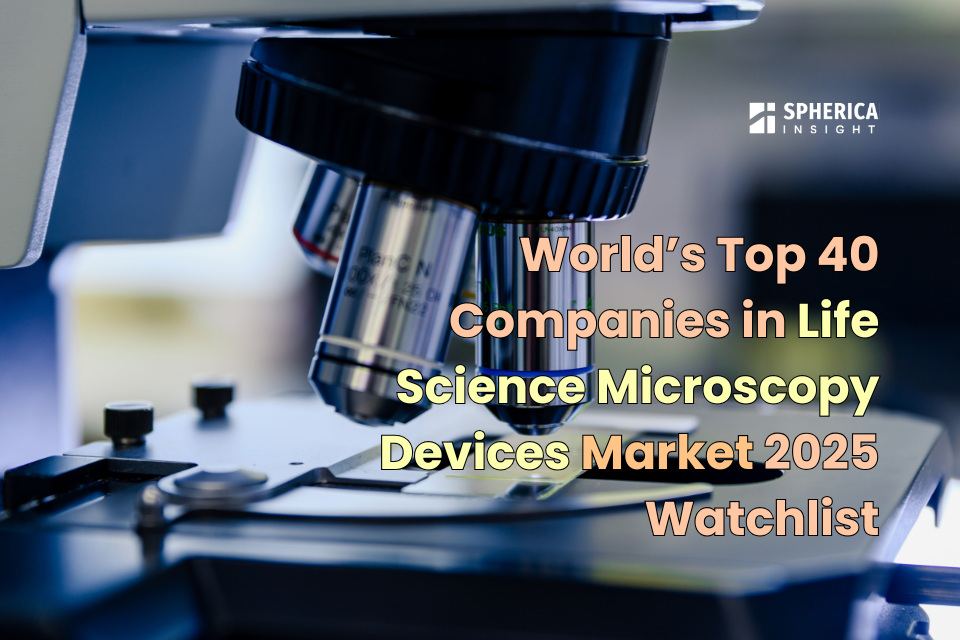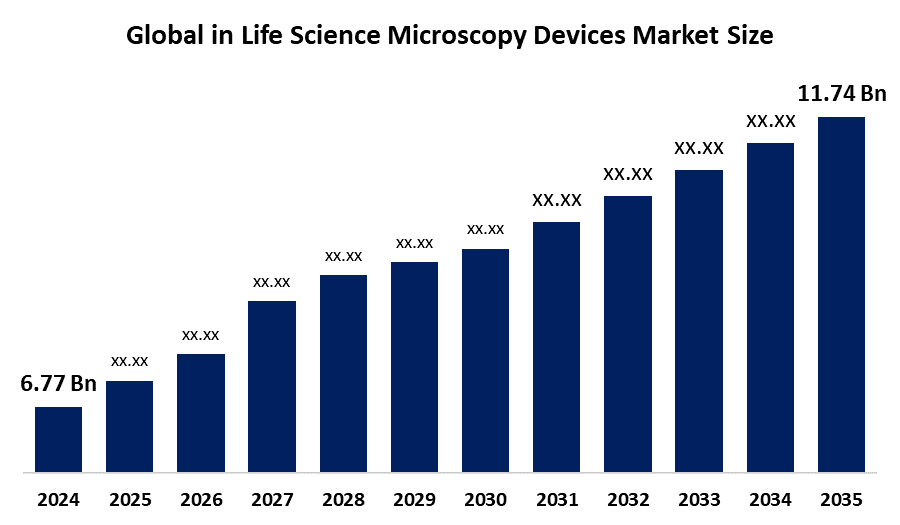
World’s Top 40 Companies in Life Science Microscopy Devices Market 2025 Watchlist: Statistical Report (2024–2035)
RELEASE DATE: Sep 2025 Author: Spherical InsightsRequest Free Sample Speak to Analyst
Description
According to a research report published by Spherical Insights & Consulting, The Global Life Science Microscopy Devices Market Size is projected To Grow from USD 6.77 Billion in 2024 to USD 11.74 Billion by 2035, at a CAGR of 5.13% during the forecast period 2025–2035. The global life science microscopy devices market is driven by rising demand for advanced imaging solutions in biomedical research, growing applications in drug discovery and diagnostics, and technological advancements.
Introduction
The Life Science Microscopy Devices Market Size includes the development, manufacture, and distribution of microscopes and other imaging equipment used to examine biological material. These tools are essential for biomedical research, pharmaceutical development, clinical diagnostics, and educational purposes because they provide high-resolution viewing of cells, tissues, and microbes. The rising global prevalence of chronic illnesses such as cancer, diabetes, and neurological disorders is a key driver of market expansion. The increasing emphasis on early detection and individualized therapy for these illnesses is pushing the need for advanced microscopy technologies. Pathology laboratories, in particular, rely extensively on microscopes to analyze biopsy samples, which helps pathologists diagnose cancers at an early stage. Continuous innovation, along with user-friendly interfaces, is helping to overcome difficulties and increase acceptance in healthcare and research. Furthermore, advances in super-resolution microscopy, live-cell imaging, and confocal fluorescence microscopy are transforming biological research by delivering unmatched levels of precision and detail. These technologies are breaking advances in molecular biology, genetics, and neurology, increasing demand for advanced microscopy systems and assuring long-term global market growth.
Navigate Future Markets with Confidence: Insights from Spherical Insights LLP
The insights presented in this blog are derived from comprehensive market research conducted by Spherical Insights LLP, a trusted advisory partner to leading global enterprises. Backed by in-depth data analysis, expert forecasting, and industry-specific intelligence, our reports empower decision-makers to identify strategic growth opportunities in fast-evolving sectors. Clients seeking detailed market segmentation, competitive landscapes, regional outlooks, and future investment trends will find immense value in the full report. By leveraging our research, businesses can make informed decisions, gain a competitive edge, and stay ahead in the transition toward sustainable and profitable solutions.
Unlock exclusive market insights - Download the Brochure now and dive deeper into the future of the Life Science Microscopy Devices Market.
Life Science Microscopy Devices Market Size & Statistics
- The Market Size for Life Science Microscopy Devices Was Estimated to be worth USD 6.77 Billion in 2024.
- The Market Size is Going to Expand at a CAGR of 5.13% between 2025 and 2035.
- The Global Life Science Microscopy Devices Market Size is anticipated to reach USD 11.74 Billion by 2035.
- North America is expected to generate the highest demand during the forecast period in the Life Science Microscopy Devices Market
- Asia Pacific is expected to grow the fastest during the forecast period in the Life Science Microscopy Devices Market.

Regional growth and demand
Asia Pacific is expected to grow the fastest during the forecast period in the life science microscopy devices market. Asia Pacific is anticipated to grow at the fastest CAGR in the life science microscopy devices market, driven by significant investments in life sciences across China, India, Japan, and South Korea. Government initiatives and healthcare infrastructure development are boosting adoption in universities, labs, and hospitals.
North America is expected to generate the highest demand during the forecast period in the life science microscopy devices market. North America is projected to hold the highest share of the life science microscopy devices market, supported by strong biomedical research, substantial NIH funding, and sustained investments in genetics, immunology, and cell biology, driving continuous demand for advanced imaging technologies.
Top 10 Trends in the Life Science Microscopy Devices Market
- Artificial Intelligence (AI) and Automation
- Cryo-Electron Microscopy (Cryo-EM)
- Portability and Miniaturization
- Super-Resolution Techniques
- Integration of Digital and Connected Technologies
- Increased Focus on Nanotechnology and Regenerative Medicine
- Demand for Hyphenated Technologies
- Expansion in Drug Discovery and Development
- Industry-Academia Collaboration
- Advancements in Electron Microscopy
1. Artificial Intelligence (AI) and Automation
AI-powered image analysis and automated processes are transforming microscopy by eliminating manual intervention, lowering mistakes, and allowing for quicker, more accurate interpretation of biological material. This allows researchers to process big data quantities more effectively and increases diagnosis accuracy in clinical laboratories.
2. Cryo-Electron Microscopy (Cryo-EM)
Cryo-EM is gaining popularity because it allows researchers to analyze biomolecules at almost atomic precision without the necessity for crystallization. This technique is changing structural biology and drug discovery by allowing us to see proteins, viruses, and complex molecular assemblies in their original states.
3. Portability and Miniaturization
The need for portable and compact microscopes is increasing, particularly for field diagnostics, point-of-care testing, and teaching. Compact devices improve accessibility, save costs, and enable real-time imaging in resource-constrained environments without sacrificing picture quality.
4. Super-Resolution Techniques
Super-resolution microscopy methods, like as STED, SIM, and PALM/STORM, are overcoming the light's diffraction limit, allowing for the viewing of nanoscale objects. These improvements promote cutting-edge research in molecular biology, neurology, and genetics.
5. Integration of Digital and Connected Technologies
The combination of cloud platforms, IoT, and digital imaging improves cooperation and data exchange among worldwide research teams. Remote diagnostics, real-time picture sharing, and enhanced data management are all enabled by connected microscopy gear, which improves efficiency and research outputs.
Empower your strategic planning:
Stay informed with the latest industry insights and market trends to identify new opportunities and drive growth in the life science microscopy devices market. To explore more in-depth trends, insights, and forecasts, please refer to our detailed report.
Top 20 Companies Leading the Life Science Microscopy Devices Market
- Olympus Corporation
- Nikon Corporation
- Bruker Corporation
- JOEL Ltd.
- FEI Company
- Hitachi High-Technologies Corporation
- Leica Microsystems
- Carl Zeiss Microscopy
- Cameca SAS
- NT-MDT
- Thermo Fisher Scientific, Inc.
- Keyence Corporation
- F. Hoffman-La Roche Ltd.
- WITec GmbH
- Hamamatsu Photonics K.K.
- CrestOptics
- Bio-Rad Laboratories, Inc.
- Photon etc.
- Basler AG
- TESCAN
1. Olympus Corporation
Headquarters: Hachioji, Tokyo, Japan
Olympus Corporation, based in Tokyo, Japan, has activities in approximately 40 countries worldwide. The firm has long been regarded as a pioneer in optical and digital imaging technology. In the life science microscopy market, Olympus contributed significantly to the advancement of biomedical research by providing high-quality imaging equipment. Although Olympus' scientific solutions branch was split off into a distinct corporation, Evident Corporation, the company's contributions to modern microscopy remain essential. Its innovations continue to have an impact in fields like as cell biology, genetics, and clinical diagnostics, where improved imaging tools are vital for research, diagnosis, and innovation in life sciences.
2. Nikon Corporation
Headquarters: Tokyo, Japan
Nikon is headquartered in Tokyo, Japan, and operates in more than 70 countries across the world. The firm is a key participant in optical technology, having established itself as a reliable provider of life science microscopy gear. Nikon's sophisticated imaging technologies, such as confocal and super-resolution microscopes, are extensively employed in biomedical research, clinical diagnostics, and pharmaceutical development. Nikon's commitment to innovation allows researchers to examine cellular and molecular processes with accuracy and depth. The company's microscopes are used in cancer research, neurology, and regenerative medicine, making it an important part of the worldwide life sciences research and healthcare ecosystem.
3. BRUKER CORPORATION
Headquarters: Billerica, Massachusetts, USA
Bruker Corporation, based in Billerica, Massachusetts, USA, operates in over 90 countries. Bruker, known for its high-performance scientific equipment, has a significant presence in the life science microscopy industry. The firm specializes in sophisticated microscopy systems, such as super-resolution, atomic force, and multiphoton microscopes, which allow for thorough imaging of biological samples. These technologies are often used in cell biology, neurology, and drug discovery research. Bruker's solutions improve scientists' capacity to capture nanoscale structural and functional insights, accelerating innovation in molecular biology and personalized medicine. Its ongoing product advancements help to increase its global footprint in life sciences.
4. JEOL Ltd.
Headquarters: Akishima, Tokyo, Japan
JEOL Ltd., based in Tokyo, Japan, operates in more than 30 countries throughout the world. The firm is a global leader in electron optics and scientific instruments, with a strong presence in the life science microscope device market. JEOL provides electron microscopes and NMR spectrometers, which are essential for high-resolution imaging and structural biology applications. Its electron microscopes are widely used in biomedical research, allowing the observation of cells, tissues, and macromolecules at sub-nanometer scales. By advancing pathology, virology, and molecular diagnostics, JEOL helps to meet the rising need for precision imaging solutions in research and healthcare organizations throughout the world.
5. FEI Company
Headquarters: Hillsboro, Oregon, USA
FEI Company, located in Hillsboro, Oregon, USA, operates in over 50 countries and is currently a division of Thermo Fisher Scientific. It is a pioneer in high-performance electron microscopy, specifically cryo-electron microscopy (Cryo-EM), a game-changing technology in life science research. FEI's equipment enables researchers to analyze biomolecules and cellular structures at near-atomic resolution, resulting in discoveries in structural biology and drug development. Its solutions are widely used in university laboratories, pharmaceutical businesses, and medical research facilities. By allowing for the viewing of complex biological systems, FEI has established itself as a key player in the advancement of modern biomedical imaging and diagnostics.
Are you ready to discover more about the Life Science Microscopy Devices Market?
The report provides an in-depth analysis of the leading companies operating in the global Life Science Microscopy Devices Market. It includes a comparative assessment based on their product portfolios, business overviews, geographical footprint, strategic initiatives, market segment share, and SWOT analysis. Each company is profiled using a standardized format that includes:
Company Profiles
- Olympus Corporation
- Business Overview
- Company Snapshot
- Products Overview
- Company Market Share Analysis
- Company Coverage Portfolio
- Financial Analysis
- Recent Developments
- Merger and Acquisitions
- SWOT Analysis
- Nikon Corporation
- BRUKER CORPORATION
- JEOL Ltd.
- FEI Company
- Hitachi High-Technologies Corporation
- Leica Microsystems
- Carl Zeiss Microscopy
- Cameca SAS
- Others.
Conclusion
The Global Life Science Microscopy Devices Market Size is poised for strong growth, driven by rising demand for advanced imaging technologies in biomedical research, clinical diagnostics, and pharmaceutical development. The increasing prevalence of chronic diseases, such as cancer and neurological disorders, is accelerating the need for early detection and precision research tools. Innovations like super-resolution microscopy, cryo-electron microscopy, AI integration, and portable imaging systems are expanding capabilities and improving workflow efficiency. Strong investments in life sciences R&D across North America, Europe, and the Asia Pacific, coupled with adoption in academic and healthcare institutions, are further fueling market expansion and long-term growth worldwide.
About the Spherical Insights & Consulting
Spherical Insights & Consulting is a market research and consulting firm which provides actionable market research study, quantitative forecasting and trends analysis provides forward-looking insight especially designed for decision makers and aids ROI.
Which is catering to different industry such as financial sectors, industrial sectors, government organizations, universities, non-profits and corporations. The company's mission is to work with businesses to achieve business objectives and maintain strategic improvements.
CONTACT US:
For More Information on Your Target Market, Please Contact Us Below:
Phone: +1 303 800 4326 (the U.S.)
Phone: +91 90289 24100 (APAC)
Email: inquiry@sphericalinsights.com, sales@sphericalinsights.com
Contact Us: https://www.sphericalinsights.com/contact-us
Need help to buy this report?